By SEMA Magazine Editors
Photography by Evan Klein and Lynn Park
Scorpion EV’s Venom Conversion Kit Provides a Plug-and-Play Solution for EV Conversions Like
This Award-Winning Shelby Replica
It’s been said that for every challenge confronting the aftermarket, there’s a solution just waiting to be found. For Bill Cardoso, CEO of Scorpion EV, the initial challenge started with his son, who, he explained in a 2022 interview with Street Muscle Magazine, is “on the autism spectrum and averse to loud noises.” Cardoso, a car lover who holds a PhD in engineering from the Illinois Institute of Technology as well as an MBA from the University of Chicago, took advantage of “all the time I had on my hands during the pandemic” to craft an elegant solution: The Scorpion 600, a 600hp Tesla-powered Factory Five Shelby Cobra replica that earned rave reviews for the fledgling company at the 2022 SEMA Show. (Scorpion makes a 1,000hp version, too.)

Not content with building conventional electric vehicles (EVs), using assorted components acquired individually, Cardoso returned to the SEMA Show in 2023 along with company vice president of business development Karen Salvaggio to exhibit another Factory Five Cobra, this one sporting a unique electric powertrain under its hood. Dubbed “Venom,” the system contains all the components needed for an EV conversion—motor, inverter, 40kWh Tesla battery packs, battery management system, DC converter, charger, water pump and coolant, control software and Tremec T-5 transmission—in a swappable, self-enclosed modular kit that’s roughly the size of a big-block V8 and which can be bolted into the engine bay of any conventional gas-powered car or truck. The kit, Salvaggio explained, was designed to meet the needs of “the very core of our industry—the DIY builders, shop owners and guy or girl working in their garage at home.” Showgoers took note, and the Venom-outfitted Cobra took SEMA’s inaugural Best Engineered Vehicle of the Year award.
We managed to chat with Cardoso and Salvaggio at the Show to learn more about their company and their kit. What follows has been edited for clarity and length.
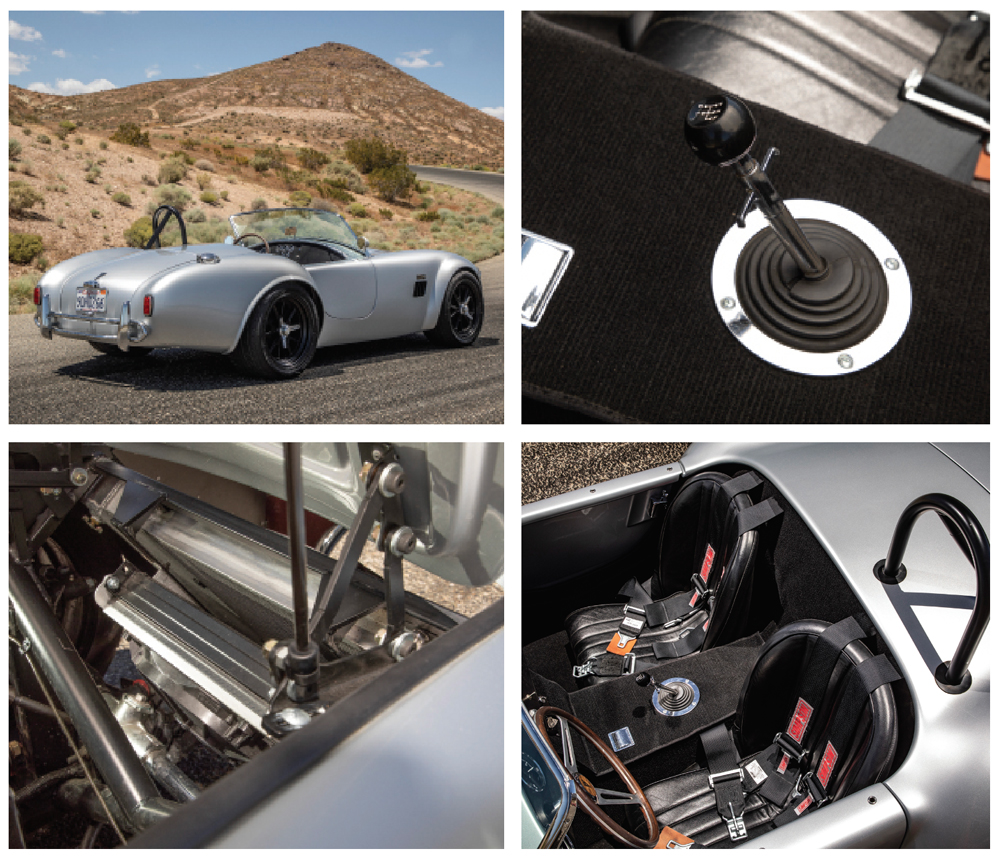
SEMA: Tell the story of how this came about.
Karen Salvaggio: Scorpion came about from a partnership of two people who love driving this type of car. One of them is, like, an EV genius guy, and then other is a 35-year veteran racer. The car is a Factory Five Mk4 roadster replica of the ’65 Shelby Cobra. We’re geeky people, but we love cars, and we love driving them fast. So the idea was, let’s take something that we know well, and Bill particularly is in the EV lane of things and very, very talented in all things electrical.
The world of EVs is expanding exponentially every day. You can see the size of the footprint it’s having at the SEMA Show. Last year we brought three cars. We had a 1,000hp all-wheel drive in the SEMA Electrified exhibit, which was in North Hall at that time. And then we had one in our partner Redline Detection’s booth in South Hall. We also had our own booth in Central Hall.
Now, when you’re in the world of innovating, you still have to listen to the market, right? So we were listening to the market, and the market was asking us, are you making conversion kits? And we were not. We were building turnkey cars—and believe me, they’re selling and they’re wonderful. But we listened to the market and went back to the drawing board and said, ‘let’s list all the objections that have ever been given about why you would not want to convert a classic car to an EV and see how we could come up with answers for them.’ We just listed them out and then we just went one by one.
You don’t want to cut up your chassis? Check. With Venom, you don’t have to do that.
You don’t want to play with high voltage? Check, it’s taken care of.
Then how do I make all these different
components work? Check. Done.
Venom is a sealed, contained plug-and-play system. There’s no high-voltage wiring to play with. You just literally pull your internal combustion engine out and drop this in. If you don’t want to lose your stick shift, it will run with the standard transmission. So you just start with objection-based work and proceed backwards, and then you partner with somebody who’s amazing.
SEMA: Bill, that seems to be your cue to pick up the story.
Bill Cardoso: Conversion projects and EV builds have been plagued with failures. We know a lot of stories of people who over the years have bought pieces and parts of EV components and end up never being able to successfully build a car because of the challenge of understanding how these pieces work together. Then, when they realize the dangers of working with high voltage, that creates another block for people to continue their dreams of driving an electric vehicle. So what we’ve done with Venom is to package everything in one sealed box. We’ve taken on all of the challenges that have prevented people from tackling these projects, like designing and manufacturing a wiring harness that connects to the instrumentation and the brake switch and the throttle. So you don’t really have to take the extra step of wiring—it’s done for you. And by removing these obstacles, hopefully what we want to do here is to enable people to realize their dreams of driving electric vehicles.
A few months ago we had a meeting with [SEMA Director of Vehicle Technology] Luis Morales and [SEMA Industry Sales Director] Andrea Brake, They’re both amazing people who have helped us throughout the process. Anyway, we were talking about Venom and how easy it is to convert. And then we had a stupid idea like, why don’t we do a conversion at the Show—live at our booth? And we both thought, well, it’s never been done before.
KS: We both thought it was a really dumb idea. It’s so risky.
BC: What’s pretty cool about SEMA, and about Luis and Andrea, is that they didn’t say it’s never been done before so it can’t be done. They said, that’s awesome! Let’s figure out how to do it right. Let us call the [Las Vegas] Convention Center and figure out what we need. How do we make it happen?
And that’s been our experience with SEMA. It’s an organization that helps us get the roadblocks out of the way so we can drive through and realize our dreams. And that’s what we did. We brought a gas-powered vehicle to the Show, and Wednesday morning we pulled out the gas engine and we put in the electric Venom EV conversion kit, and we drove it back and forth a few times so people would know it was real. The whole thing took 19 min.
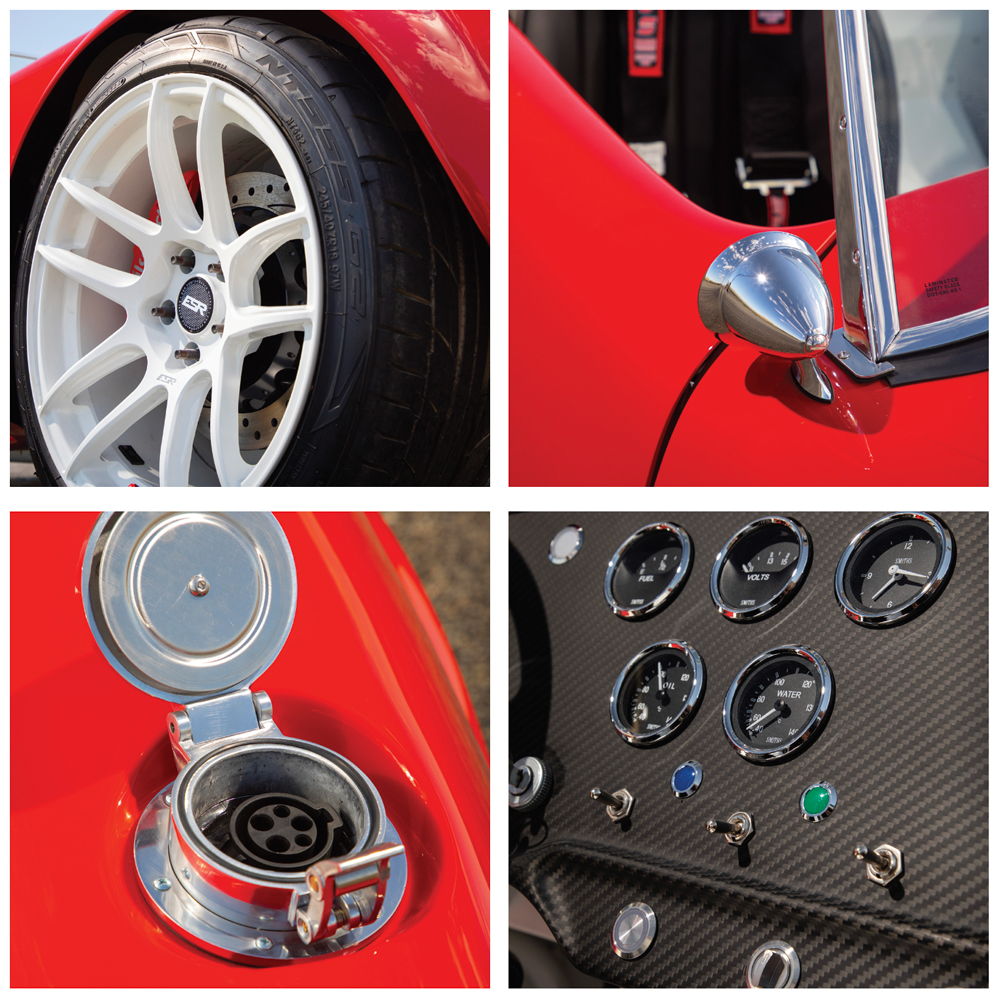
SEMA: It’s really funny that Karen mentioned that it was a ‘dumb’ idea because it was a risk.
BC: A massive risk!
SEMA: But that’s what this whole industry is. The people who are the innovators in this industry are the people who are willing to take a risk. And you guys did that.
KS: Any time that I speak about what we’re doing or even like the long careers we’ve had in other worlds, we say that life is about risk-taking. And actually, every exhibitor at the SEMA Show who has a new product or who’s brought a Battle of the Builders [vehicle], they’re taking a very high risk for a potentially very low return.
There are so many people who ask, how do I get to race? How do I get to be on the Hot Rod Power Tour? How do I get a booth at SEMA? How do I even get a badge for SEMA? And it’s simple—put yourself out there. Tap yourself into the industry.
I’ve got to give a shout out to SEMA’s ETTN [Emerging Trends & Technology Network]. I’ve been very blessed to serve on several committees and councils with SEMA, and I love working with our ETTN group; those guys are the innovators. We happen to be in that lane with them, and their energy is incredible.
BC: There’s something else that’s important to talk about when you discuss risk. As a business person, we want to mitigate risk, right? We want to minimize the chance of failure. So going back to the EV conversion we did at the Show, it was a massive risk! It could have failed. A lot of things could have failed. We got these awesome floors from Swisstrax, but we didn’t know if things would roll right.
KS: And we couldn’t practice this at home.
BC: To truly ‘Be Legendary’ in business requires you to take risks, but you also have to be in an environment that tolerates risk, that doesn’t see risk as a failure, but sees risk as, “Hell yeah, man. You tried. Well done. Let’s try again!”
KS: And that’s what we got from Luis and Andrea. When we pitched an idea to them, they picked up an oar and rowed in the boat with us.
BC: Even if you fail, you’re going to learn a ton.
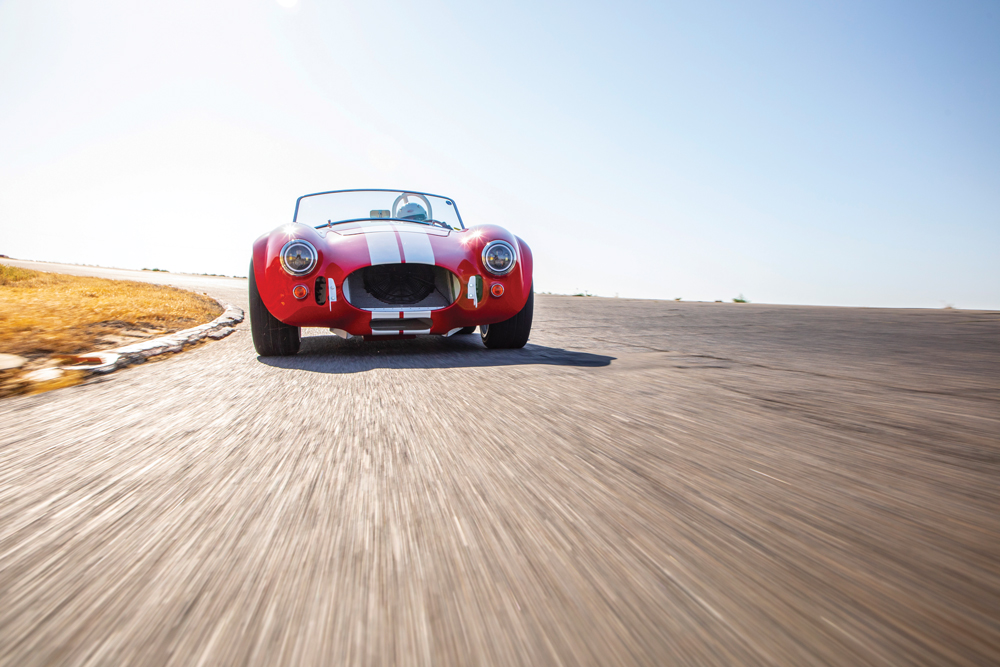
SEMA: Beyond the association itself, you had tons of interest in your Show exhibit. Why don’t you tell us about the reaction of people at the Show to what you’ve done?
BC: The first reaction has been some confusion because the expectation right now when you talk about EV conversion is that there has to be a certain level of complexity to it. The fact that we’ve been able to systematically package this whole thing in one box has caught people by surprise. So once you ‘get it,’ it becomes an awesome conversation. And we’ve been talking to people who want to swap whole fleets of cars and rentals and things like that, but they haven’t been able to because it’s way too complex and way too expensive. What we’re providing is a path of enablement so people can accomplish what they’ve been trying to do for a while.
KS: I’ll go back in time a little bit because in a way what we’re doing is like what the hot rodders in the ’40s and ’50s were doing. The guys who are legendary in our industry were doing all of kinds of crazy things to their cars in those days that a lot of people didn’t like or just didn’t understand.
To see how far this industry has gone, even in the last four to five years, has been really remarkable. Last year when we were here, we still had a number of people who would walk by and look at us, like, “Never!” and make some nasty sound. I mean, we’ve heard it all. But we’re not getting so much of that reaction now.
The more people see EVs driving down the road, the more they’re seeing these cars as real and obtainable, and they’re beginning to understand how an EV can fit into their life. And they might think, I have this car, my dad’s old whatever-it-is that he gifted to me, and I can turn it into something that’s next-gen. These are people that are thinking way out of the box, and the collective mindset of the industry is changing.
SEMA: We’re hearing some of the ‘old-timers’ tell us, ‘This isn’t really my thing, but boy, I want one,’ and this is the first time we’re hearing this on any scale.
KS: That’s what we’re hearing on this side. And you still have those who will walk by and maybe they want it, but they won’t come over yet.
SEMA: Part of the beauty of this, though, is that if the person decides, for whatever reason, that they need to reverse-engineer it, the Venom unit comes out and the gas engine goes back in.
BC: Yeah, you can always put back the internal combustion engine and drive it again. You don’t have to remove the gas tank. You don’t have to remove any of those things that are auxiliary. And for the most part, you’re going to have a much more reliable car at the end of the day that you can actually drive with the push of a button.
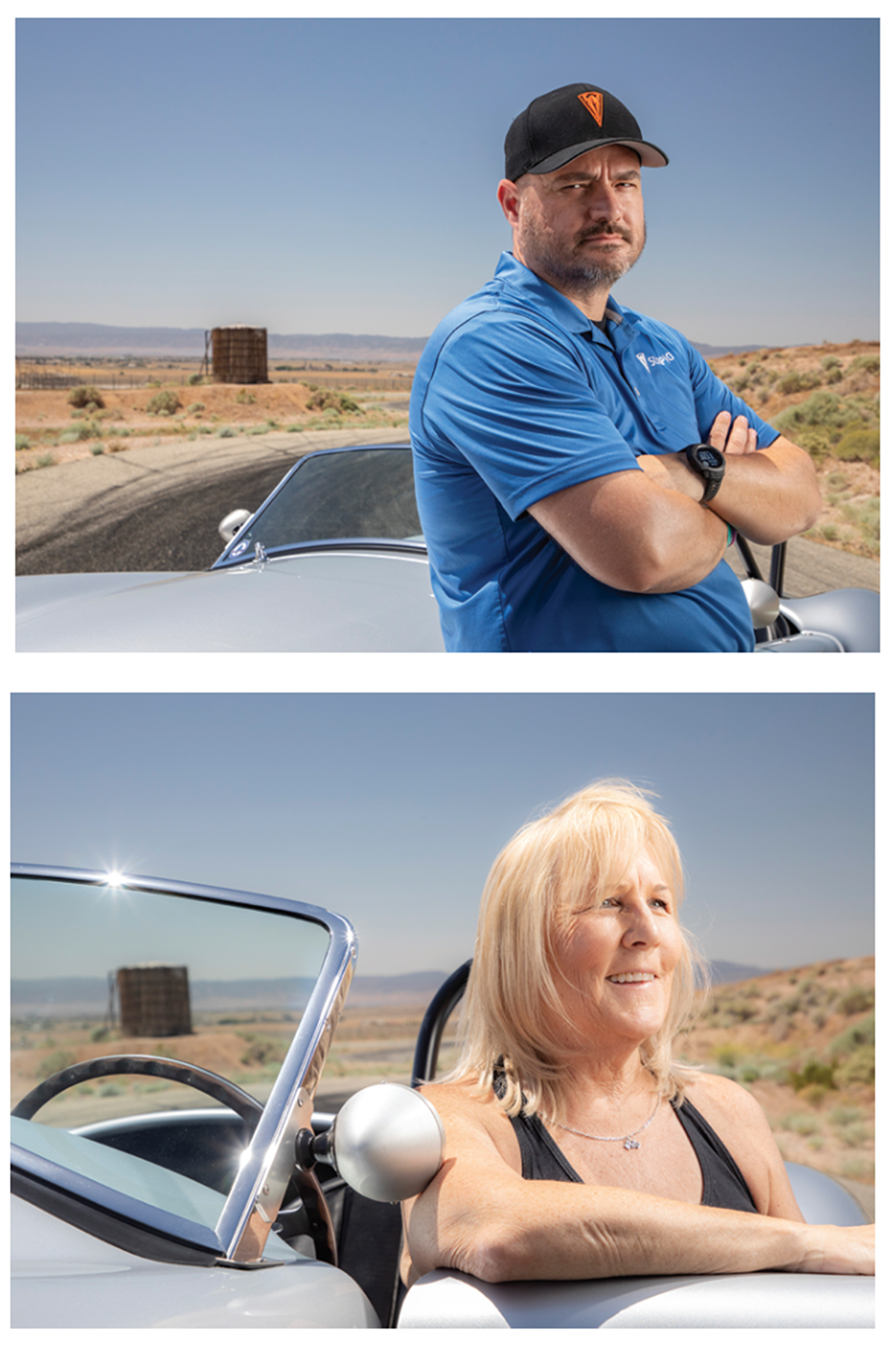
SEMA: There must have been a lot of blood, sweat and tears that went into the development
of this.
BC: This is a product that is 100% made in the United States. We developed everything from the ground up, which is pretty cool because we have full control on the design and any modifications that might be made in the future. We work with an amazing team of electrical engineers and mechanical engineers who have helped with how we package this. There is a lot of stuff in the box. You have to be sure that electrically the system is sound from a high-voltage perspective, and that mechanically things are sound so things don’t shift when you’re driving the car.
The cool thing about the Factory Five Cobra is that people don’t drive them lightly. It’s a spirited drive, so that allowed us to put quite a bit of mechanical stress on the box and make sure
everything works fine.
Then we also have the thermal design of the components. The motor runs hot, and the batteries have to be water glycol-cooled, so you have to think about these things from a ‘systems perspective’ to ensure that it all works well as a system.
SEMA: A lot of concerns about EV conversions revolve around weight distribution. And it seems like you haven’t really changed that dynamic
at all.
BC: Yeah, think of it as a big-block. An electric big-block.
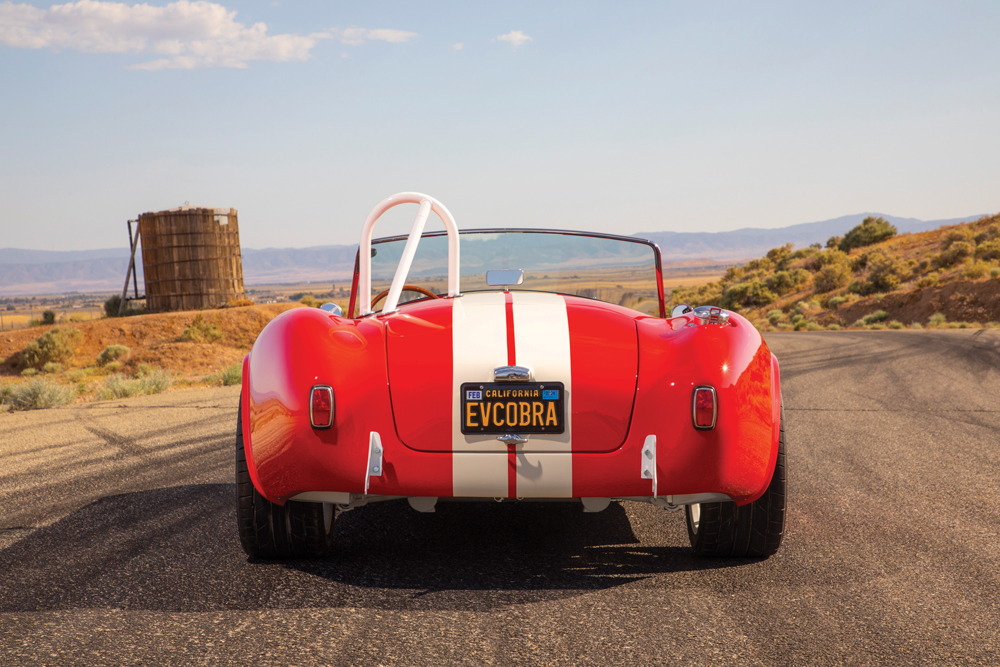
SEMA: Who’s the owner of the car?
BC: That’s me.
KS: We can both tell you that the car is a ton of fun to drive.
SEMA: What’s your price point for the kit?
BC: Forty grand. It comes complete, all wired in, so you don’t have to really do anything else but install it.
SEMA: So this is fairly affordable for somebody who wants to do something like this.
KS: We’ll give you a good deal. (Laughs.)
SEMA: Wrapping up, what does it mean to win the first SEMA Show Best Engineered Vehicle award?
KS: Oh my gosh. You walk around these halls and you look at what has been executed and built, the excellence, the number of incredible vehicles and the ingenuity and hard work, and you imagine the sweat, the cut fingers, all of that. To even be nominated among this group is amazing. And then to actually snag that trophy and bring it home—
we were pretty much speechless. I mean, honestly, speechless. It means everything to us because we know the quality of the people who are judging. We know the industry that we live in and the platform upon which we stand with those people. To be acknowledged like that is phenomenal.
BC: Like Karen said, it was humbling. I think that’s the best word to describe it for me and for our team. It’s a recognition that SEMA is an organization that allows you to fail because that’s where success comes from. Does that make sense?
SEMA: Absolutely.
BC: Going into this, as we mentioned before, we didn’t know if what we were going to attempt was going to work. And all the things we talked about had a fairly high probability of failure.
Then you’ve got the added pressure of a lot of people here who would love to see something like this fail. Let’s be honest—there’s a whole host of people who wouldn’t want to see this work. But we have an incredible amount of deserving people and are super-happy to be honored.
KS: For the trophy to reside on top of our “engine” is humbling. That’s the best word for it.
Douglas McColloch compiled and edited this story. Interview by Michael Imlay.





